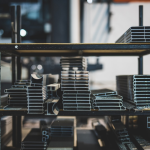Is Stainless Steel Magnetic? Unraveling the Nuances of This Versatile Alloy
Stainless steel is an alloy composed primarily of iron, chromium, nickel, and various other elements depending on the specific grade. This combination results in a corrosion-resistant material with exceptional strength and durability, making it ideal for a wide range of applications. However, this aesthetically sleek material faces a common misconception — that it is non-magnetic. The answer, however, is not so straightforward.
In this exploration, we’ll delve into the magnetic intricacies of stainless steel, uncovering the science behind its nuanced magnetic and non-magnetic characteristics.
The Three Faces of Stainless Steel
The versatile alloy that is stainless steel can be separated into three main groups based on its crystal structure and magnetic attributes: austenitic, ferritic, and martensitic.
- Austenitic Stainless Steels: The behavior of austenitic stainless steels is generally non-magnetic. This is due to its high levels of nickel and manganese.
- Ferritic Stainless Steels: This group of stainless steel is magnetic. This is due to the presence of iron and higher chromium content, but lower nickel levels vs. austenitic steels.
- Martensitic Stainless Steels: The behavior of martensitic stainless steel is magnetic. This is because of its higher carbon content and magnetic characteristics resulting from a specific heat treatment.
Factors Influencing Magnetism
Several factors influence the magnetic properties of stainless steel:
- Composition: The ratio of iron, chromium, nickel, and other elements determines the magnetic or non-magnetic nature of the alloy.
- Cold Working: Cold working processes, such as rolling or bending, can induce magnetism in stainless steel.
- Heat Treatment: Certain heat treatments can alter the crystal structure of stainless steel, affecting its magnetic behavior.
Real-World Applications
Understanding the magnetic properties of stainless steel is vital in various industries:
- Kitchen appliances: Magnetic stainless steel is often used in the construction of kitchen appliances, such as refrigerators and dishwashers.
- Architectural design: Employed in architectural applications, magnetic stainless steel combines functionality with an aesthetically pleasing finish.
- Automotive industry: Parts and components in the automotive industry may utilize magnetic stainless steel for its strength and corrosion resistance.
Apex Magnets
In conclusion, the magnetic complexity of stainless steel adds an intriguing layer to its already impressive list of qualities. The three distinct groups— austenitic, ferritic, and martensitic—highlight the diverse magnetic behaviors that arise from variations in composition and heat treatments. This knowledge is crucial in practical applications across industries, from the sleek kitchen appliances we use daily to the structural elegance of architectural designs and the robust components in the automotive sector.
We’re always working on ways our customers can use our magnets and other products, from hobbyists and crafters to manufacturers and business owners. Sign up for our newsletter to get these stories and more sent straight to your inbox each month.

